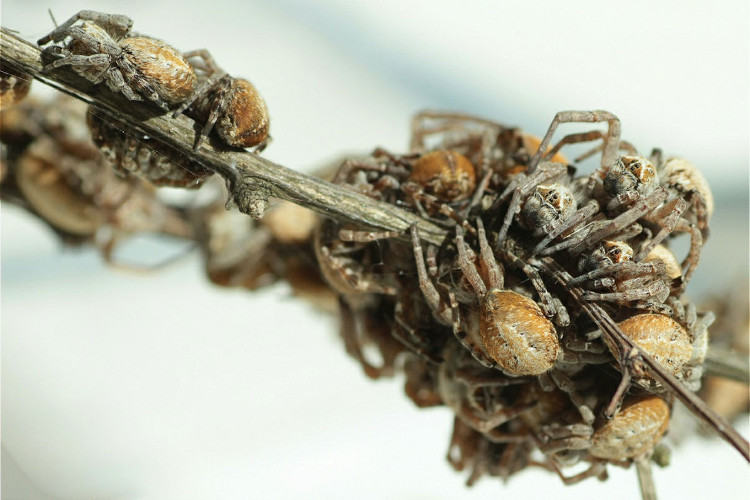The 'virgin' spider donates itself as a prey for the young spider mite
The female spider has them with a mother spider that accepts herself to become a banquet for gluttonous spiders.
The velvet spiders (Stegodyphus dumicola) donate their own bodies as meals for young hungry spiders according to the results published in the October issue of Science Direct, New Scientist reported. The young spider mite drains the essence inside the spider aunt's body when its body liquefies naturally, leaving the virgin spider leaving only the dried corpse.
"Young spiders start eating spider meat when it is still alive," said researcher Trine Bilde of Aarhus University in Denmark. The young spider injects enzymes to dissolve the aunt spider's organs and suck the liquid, leaving only the empty shell. "But that is clearly not rough behavior. That behavior is like a spider inviting a spider to eat them , " Bilde said.
S. dumicola is a highly social spider and lives in large common nests. Hundreds of spiders coordinate to catch prey, protect the nest and take care of the young. The nest is made of tangled silk thread and plant material, with many two-dimensional nets to catch prey. Each spider lives only one year, so they can only reproduce once.

Spider velvet, I sacrifice myself as bait for my grandchildren.(Photo: New Scientist).
In S. lineatus , spiders have families close to S. dumicola, only mating females take care of the young. Pairing seems not only to push the female spider to care for their young, but also the spiders are not born by them. This behavior is called "alloparenting" . However, the restriction is that they only allow children to eat themselves.
Bilde and her colleagues wanted to find out if the mating S. dumicola has not yet mated or not. They propagated spiders in the laboratory and divided them into several groups, each with two mating females and three virgin spiders, and several young, to observe their behavior.
Both the female and the female mating spiders are all responsible for being a homosexual mother. They look after the eggs, vomit the food for the spider and finally give their own bodies to make meals for the young. This particular behavior has many meanings because all spiders living in the nest are closely related and share the same genetic resources. The number of female spiders is larger than that of male spiders and only some females reproduce, so spiders in the herd have many similar genetic characteristics.
"Investing in the offspring in that way is a successful investment in reproduction. The better the child transmits many genetic copies for the next generation and offers the body as food as a wise evolutionary solution." , Bilde commented.
"I suspect that female spiders simply cannot distinguish their eggs and other offspring," said researcher Jonathan Pruitt at the University of California, Santa Barbara. "Spider spiders are made up of animals that have a common surname, so even if the female spawn, helping a close relative is still beneficial."
Spiders' habitats can also be a factor. "Spiders of Stegodyphus species live in arid, desert areas, where prey is very scarce , " said Mor Salomon, a researcher at the Cohen Biological Control Institute in Israel. "A female spider sacrificing herself will help provide more food than they earn by hunting."
- The 'threshing' spider catches like a western cowboy
- Marvel at the clever way of catching spider venomous snakes
- Find out that spiders know to ride prey waves like old water gods
- Detecting eyeless spiders
- Reveal the male spider's cause of eating mates
- Spiders can release silk to neutralize prey
- Caterpillars wear spider mite
- Poisonous spider encased mice in silk cocoons to eat gradually
- Spiders use 'bird prey'
- Spiders eat together and stay together
- Spider 'artist' traps prey with light
- Mysterious jump of Adanson spider
 Animal 'suffering' after hibernation
Animal 'suffering' after hibernation Why do goats climb well?
Why do goats climb well? Scientists were surprised to see chimpanzees eating turtles
Scientists were surprised to see chimpanzees eating turtles Giant catfish died deadly due to drought in Thailand
Giant catfish died deadly due to drought in Thailand Spiders can lure male fireflies into their nets with their 'love calls'
Spiders can lure male fireflies into their nets with their 'love calls'  Unique techniques help animals 'survive' through winter
Unique techniques help animals 'survive' through winter  NASA finds out the truth about 'Mars spiders' in 'Inca city'
NASA finds out the truth about 'Mars spiders' in 'Inca city'  The strange way of 'taking care of children' of giant sea spiders
The strange way of 'taking care of children' of giant sea spiders  New research reveals the mystery of jumping spiders' dreams
New research reveals the mystery of jumping spiders' dreams  Scientists turn spider corpses into 'zombie robots'
Scientists turn spider corpses into 'zombie robots' 